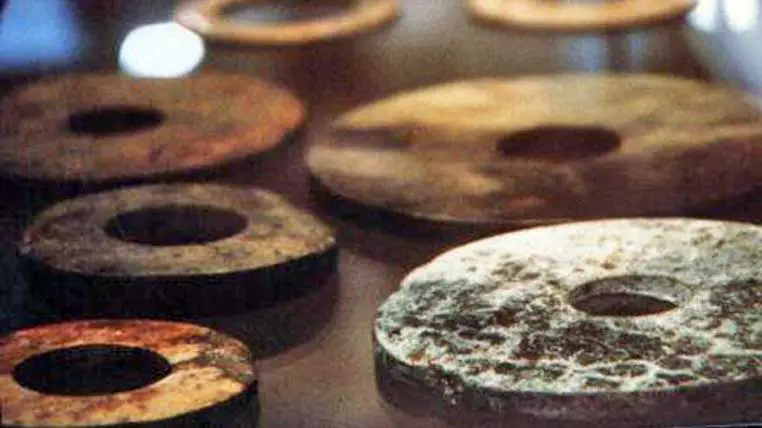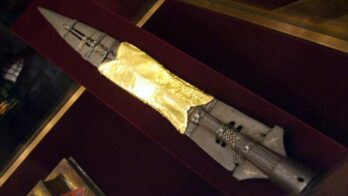The story of the Dropa Stones intertwines with the tale of two mysterious tribes, the Dropa and Ham, who reside in Tibet’s Bayan Kara Ulla mountains in the vicinity of countless interconnected caves sacred to the two tribes.
Local legend has it that no human has stepped inside these caves for centuries.
The Mysterious Tribes of Tibet
The current Dropa and Ham tribes, comprising around 3,000 people, have a unique genetic and racial makeup.
They exhibit frail physiques, thin bones, large orbits, and an upper cranial capacity exceeding the average of the Homo sapiens race by about 100 cm3, making them different from any terrestrial race.
Blood analysis also revealed their blood type is unique, supporting the hypothesis that these tribes might not have a terrestrial origin.
In 1935, a team of Chinese archaeologists finally entered the labyrinthine galleries, uncovering shocking details about the tribes.
They discovered hundreds of skeletons of humanoids, not exceeding 3.2 feet in height (about 1 meter), in the caves near the tribes’ villages.
The skeletons had skulls with a capacity of 2,500 cm3, and their age was estimated to be about 12,000 years old using the C-14 method.
Aside from the skeletons, the walls of the caves had numerous drawings that accurately depict the position of the Sun, Moon, and several dozen stars from the period.
Among the drawings was a fresco representing a squadron of small flying ships approaching the mountains at an oblique angle.
12,000-Year-Old Cobalt Alloy Discs
During an expedition, two members stumbled upon a strange hard stone disc in the most extensive cave. After two months of research, 716 identical and beautifully crafted discs were found, later named the Dropa Discs or Dropa Stones.
The stones were taken to Beijing for analysis. It was discovered that they were not just mere stone objects crafted in the Paleolithic age but actual electromagnetic discs containing 40% cobalt and 8% aluminum.
When in contact with a source of electric energy, the Dropa Stones immediately entered into a strong, rhythmic vibration.
Even more fascinating is that these achievements were made more than 12,000 years ago, well before Great Britain produced the first memory discs for computers made of an alloy containing 42% cobalt, 12% titanium or tungsten, and 46% aluminum or special steels.
Furthermore, Chinese researchers observed that all 716 discs had finely engraved unknown writing signs on both surfaces, spiraling from a central hole to the edge.
Chinese professor Tsum Um Nui, along with four linguistic collaborators and a team of physicists, worked for over 20 years to translate the texts on all Dropa Stones.

The language on the stones had no similarity whatsoever to any other living or dead terrestrial languages.
Ancient Aliens from Space?
After two months of research, scientists discovered 716 identical discs that they named the Dropa Discs or Dropa Stones.
These were taken to Beijing for analysis, where it was established that they were true electromagnetic discs containing 40% cobalt and 8% aluminum, not mere stone objects crafted in the Palaeolithic.
Chinese researchers observed that all 716 discs had finely engraved signs of unknown writing on both surfaces, starting in spirals from a central hole to the edge.
Chinese professor Tsum Um Nui worked for more than 20 years, along with four linguistic collaborators and a team of physicists, before translating the texts on all Dropa Stones, which had no similarity whatsoever to any other living or dead terrestrial languages.
The result of the translation was so incredible that three years of checks passed before the Beijing Prehistory Academy authorized the publication of the work of archaeologist Tsum Um Nui, under the title “Spiral Inscriptions recounting the arrival of spaceships.”
According to the text engraved on the discs, the arrival occurred more than 12,000 years ago.
The deciphered texts refer to the ancestors of the current Dropa and Ham tribes, asserting that they were representatives of an extraterrestrial civilization, which had to remain on Earth, declining in both civilization level and physiology over the ages.
Part of the texts analyzed on the Dropa Stones refers to the Ham population, who lost their own airships, irreparably damaged upon landing on the mountain terrain and were forced to remain on Earth since they could not repair them or build new ones.
One fragment from a Dropa disc recounts the unfortunate landing: “At Red Rock Canyon of the Serpent’s Defile, our ships could not land and collided with the surrounding rocks, shattering their rims.”
Most texts describe the frequent and bloody clashes between the “Earthlings” and the Dropa warriors, which brought heavy losses to the terrestrial Tibetan tribes but ended with a peace forced by necessity.
The Dropa descended from the clouds in their aerial ships, and ten times until sunrise, the men, women, and children hid in caves.
Finally, they understood the messages that said that this time the Dropa had come with peaceful intentions and called them to help, for their ships had broken down.
The discovery of metal fragments at the bottom of a sacred cave was the latest surprise and by no means the least significant one.
The appearance of metal in Tibet only in our era or the degree of erosion on the metal pieces certify an age of over 12,000 years.
However, there is too little information about these discoveries, which have only been published in two scientific journals: Science et Vie, Nature, and Science Digest, and have not yet reached the public.
Mysterious Human Remains Baffle Scientists
Scientists are baffled by the discovery of mysterious “human” remains in various locations around the world.
These findings challenge our understanding of human evolution and raise questions about the existence of different humanoid species.
For example, in the sacred caves of the Dropa and Ham tribes, human remains with unusual physical characteristics were found. In addition, several other discoveries have left scientists scratching their heads.
In 1982, nearly 1,000 skeletons were found in an ancient necropolis near the German city of Soest. The average height of these skeletons was 6.5 feet (2 meters), and the tomb of a military leader had a skeleton measuring 7.5 feet (2.3 meters).
Similarly, in Flanders, two skeletons over 30,000 years old were discovered. One of the skeletons belonged to a tall man measuring 8.1 feet (2.47 meters), while the other was a woman with a height of 7.8 feet (2.38 meters).
Pharaoh Ramses II’s mummy, displayed at the National Museum in Cairo, measures almost 6.5 feet (2 meters). Moreover, an ancient necropolis in Central Africa, dating back over 20,000 years, contained 60 skeletons of men who were 9.3 feet (2.85 meters) tall.
Despite the known average height of the Amerindians, several surprises were found on the American continent.

In California, miners discovered the mummified remains of a 6.7-foot-tall (2 meters) woman in 1895.
In 1898, anthropologists from Harvard University discovered another female skeleton measuring 7.8 feet (2.38 meters) in the same area. Additionally, several skeletons with a height of 7.87 feet (2.4 meters) were found in North Carolina in 1876 and Wisconsin in 1912.
In 1930, an ancient cemetery containing hundreds of graves of a population with an average height of 8 feet (2.44 meters) was discovered in Northern Mexico.
In August 1982, a female skeleton over 3,500 years old was found in the Soviet Union. This skeleton, now displayed at the Hermitage Museum in Saint Petersburg, was 8.7 feet (2.65 meters) tall.
Some of the most sensational discoveries, however, involve completely different humanoids.
For instance, in 1976, an archaeological team led by Romero Valencia unearthed the skeleton of an unknown humanoid near the Mexican capital.
This skeleton had smooth shoulder blades, a spine devoid of ribs and dorsal apophysis, and arm bones traversed by numerous holes and canals that presumably contained veins and the nervous system.
Moreover, the skull resembled that of a dog, with no orbits but instead only had a kind of bony “trumpet.”
Although the director of the Anthropological Museum of Ciudad de Mexico refused to provide details, French and American specialists believed this being was not of terrestrial origin.
In the 19th century, Eugene Dubois discovered the remains of a strange Pithecanthropus in Java, consisting of two molars, a skullcap, and a femur.
These remains presented a series of bony protuberances resembling apophyses, which were identical and equally spaced.
While the official explanation of these hypertrophies was either rheumatism or mechanical injuries, some experts doubt this explanation, given the nature of the injuries.
Are Dropa Stones Real?
The Dropa Stones present us with a fascinating potential history of the Dropa and Ham people, supported by the mysterious human remains discovered.
How was it possible for a primitive civilization to create the mysterious Dropa Stones from alloys of metals that wouldn’t become known until many millennia later? What is the history of these enigmatic hieroglyphs?
Many questions are raised concerning the human remains discovered deep within sacred caves.
Could there have been a connection between that unknown civilization and the giants of ancient times?
The discovery of the Dropa Stones is surrounded by controversy and skepticism. Some argue that the stones are just a simple hoax, while others believe they are genuine artifacts with a fascinating history.
One of the main controversies surrounding the Dropa Stones is the artifacts’ authenticity. Some critics argue that the stones are simply round with grooves carved rather than genuine ancient artifacts.
Others point to the fact that there are no historical records or evidence to support the existence of the Dropa people or the Ham tribe, who are said to have created the discs.
Despite the lack of concrete evidence to support the existence of the Dropa people and the Ham tribe, the stones remain a fascination for many people.
While some continue to dismiss them as a hoax, others believe they offer a glimpse into an ancient and mysterious civilization that may have existed long ago.
At Ancient Theory we only use trusted sources to document our articles. Such relevant sources include authentic documents, newspaper and magazine articles, established authors, or reputable websites.
- Joanna Gillian - The Mysterious Dropa Stones - Fact or Fiction? ancient-origins.net.
- Dropa stones. wikipedia.org. [Source]
- Myths & Mysteries: Are the Dropas an alien race? dawn.com.
- The Dropa Stones. International Society for the Research and Preservation of Paranormal Artifacts.
- Kimberly Alt - Controversy and Unexplained Theories of Dropa Stones. exploringlifesmysteries.com.






